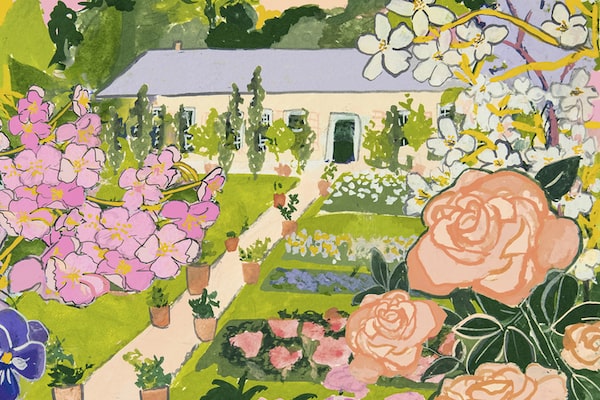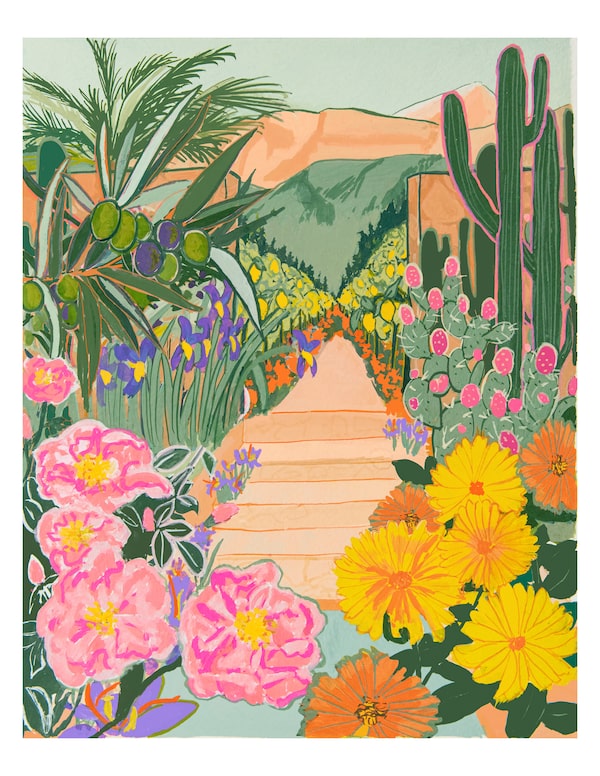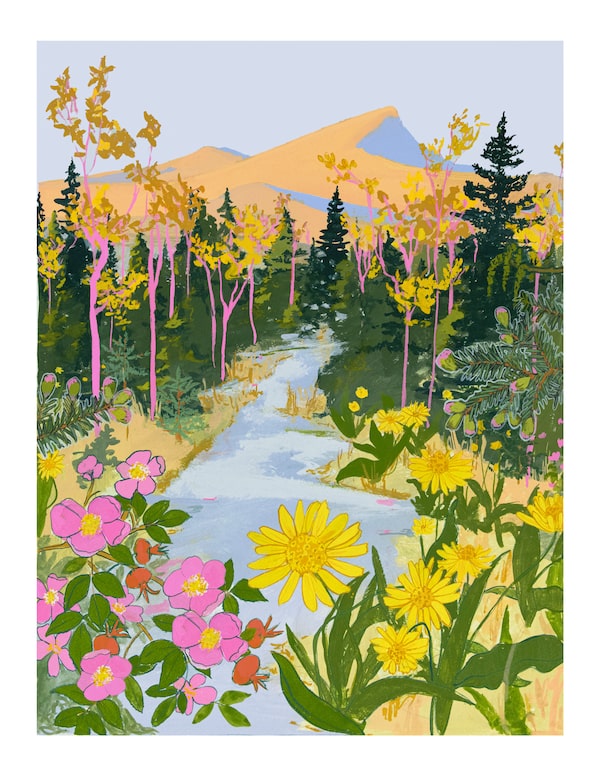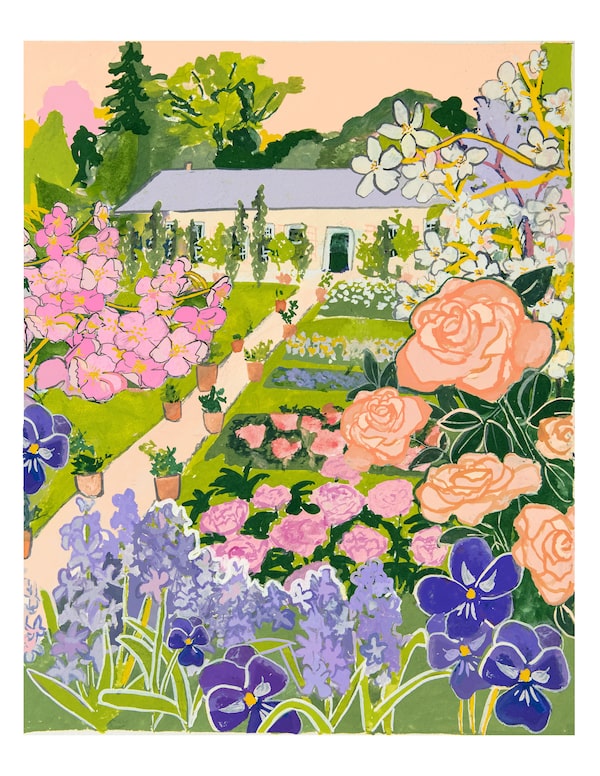
From Versailles to the Yukon, environmental stewardship helps cosmetics brands reinforce their eco credentials. Illustrations by Liz Miles
Consumer pressure has forced many players in the beauty world to be transparent about their clean and green credentials. But the companies that have long invested in a natural approach go beyond what’s printed on their product labels to care for the environments where their raw ingredients are found. This stewardship of spaces from cultivated gardens to raw landscapes was often essential to the success of heritage makeup, fragrance and skincare brands, and it’s once again part of the gold standard for how cosmetic ingredients should be cultivated.
Take Weleda, the Swiss skincare brand beloved for its Skin Food, a rich lotion introduced in 1926, for example. Its founder Rudolf Steiner essentially invented biodynamic farming, an agricultural approach that considers a farm as a cohesive ecosystem. The philosophy is now at the core of the booming natural wine industry.
When luxury fashion conglomerate Kering acquired niche French fragrance brand the House of Creed for a reported US$2-billion in June, it distinguished the perfumer as one of the last luxury fragrance houses to carefully source, research, inspect and commission its own natural raw ingredients (including rose from Bulgaria, Turkey and Morocco, Florentine iris, Calabrian bergamot and Haitian vetiver).
The three brands profiled here – Yves Saint Laurent Beauty, Anto Yukon and Maison Francis Kurkdjian – share a similar mission but apply it in unique ways in their corners of the natural world.
Yves Saint Laurent Beauty uses its Moroccan roots to inspire conservation in the Okanagan

Illustration by Lizz Miles
When the Algerian-born, Paris-based fashion designer Yves Saint Laurent visited Marrakech for the first time in 1966, he was stunned. “This city opened my eyes to colour,” he said, a strong statement from the designer known for his sartorial explorations of vivid pinks, deep blues and saturated yellows. That aesthetic connection has been preserved through the Jardin Majorelle, which Saint Laurent and his partner Pierre Bergé started stewarding in 1980. His intense attraction to Marrakech has gone on to infuse Yves Saint Laurent Beauty, a collection of luxe skincare, fragrance and makeup. Today, the house has doubled down on its Moroccan legacy through its use of botanical ingredients and its legacy of supporting natural ecosystems around the world.
“He was really inspired by the light, and the special light of Morocco that gives an intensity to the colours,” says Laurence Benaïm, a French journalist and the official biographer of Yves Saint Laurent. In beauty collections over the years, that’s been interpreted through Majorelle-blue nail polish, burnt Zellige lipstick and eyeshadow palettes that mimic a warm Moroccan sunset. But beyond aesthetic considerations, the natural environment of Morocco continues to inform company’s sustainability initiatives.
“I would say that the biggest challenge and really the next chapter for us is to continue to accelerate the reduction of our impact because that’s the main pillar of sustainability,” says Caroline Negre, global sustainability and scientific director for Yves Saint Laurent Beauty. She points to the advent of refillable products, which reduce consumer impact while offering customers the luxurious experience they’ve come to expect from the brand.
In 2014, Yves Saint Laurent Beauty opened the Ourika Community Gardens, which lie some 30 kilometres from Marrakech in the shadow of the Atlas Mountains and are home to 200 species of plants and flowers. There, the brand works with a co-operative of local women who responsibly cultivate the ingredients. According to Benaïm, the gardens go beyond brand storytelling to maintain a deep connection with the North African roots of the designer. “It’s about reharvesting the legacy of Yves Saint Laurent through nature and through the relation that could be between art, nature and beauty,” she says. “It’s a living painting.” Visitors will find clusters of prickly pear cacti, whose flowers are used in the Y Shape Serum, cherry orange calendula that’s used in the Touche Éclat brightening range, and rows upon rows of purple iris flowers that will eventually make their way into the volumizing Lash Clash Mascara. By 2025, all new Yves Saint Laurent Beauty products will contain ingredients from the gardens.
Globally, these initiatives all come together in Rewild Our Earth, the brand’s environmental commitment developed with Re:Wild, a conservation group founded by a group of conservation scientists together with Leonardo DiCaprio. The goal of Rewild Our Earth is to protect and restore 100,000 hectares of wildlife in locations such as Morocco, Haiti, Madagascar and Indonesia by 2030. In Canada, it has set its sights on the South Okanagan Grasslands, a national biodiversity hotspot within the traditional territories of the Syilx People of the Okanagan Nation that’s home to federally protected salamanders, woodpeckers, bats and rattlesnakes.
Anto Yukon creates a sense of place through locally foraged botanicals

Illustration by Lizz Miles
The Yukon is about as far away as you can get from the heritage beauty houses on New York’s Fifth Avenue or Paris’s Champs-Elysées, and that’s exactly what makes Anto Yukon so special. Through her line of bath and body products made locally using wild-harvested ingredients, founder Kym Rempel pays homage to the great outdoors of the territory.
Like many entrepreneurs in the area, Anto’s founder is a transplant who fell in love with the natural beauty of the Yukon, moving there from Ontario soon after she finished high school and carving out a career in land management. Part of her mission, first through the Anto Yukon brand and now at her store in Whitehorse, is to give a platform to an element of northern culture that isn’t necessarily tied to the historic places that come to mind when thinking of small communities in the North. “I really wanted to reflect the modernity of the Yukon. We have so many young people and creativity here that people don’t necessarily see.”
To capture that spirit through Anto Yukon, Rempel and her crew gather throughout the warmer months to harvest ingredients. “It’s a really fun part of the job. We drive out to places and it’s basically like going for a hike or a walk in the wild. We’ve identified certain areas where we can just go out with a basket or a bag and collect.” In the springtime, that’s balsam buds and spruce tips. In the summer, they’ll look for rose petals, fireweed and arnica, and rosehips in the fall. “They’re quite plentiful so there’s not really a risk of overharvesting,” she says of the raw ingredients collected during her harvest, an approach that includes leaving enough on each plant so it can continue to grow, leaving petals for bees and spreading out harvesting areas.
Named for places including Kluane National Park and Reserve, Fox Lake and Dawson City, Rempel’s products are evocative of grand vistas. “We’re more about the colours and the smells and feeling that appreciation of beauty of a place as opposed to a rugged and challenging interpretation of wilderness or vast landscapes,” Rempel says. Each bar of soap features packaging adorned with a reproduction of an original painting by the B.C.-based artist Meghan Hildebrand, who was born and raised in the Yukon and takes inspiration from the area’s biodiversity and the feelings it stirs. “I think that ties back into the nature of the brand,” Rempel says. “Creating something that’s reflective of the Yukon that also has a contemporary, fun, modern element to it.”
Maison Francis Kurkdjian revives the Perfumer’s Garden at Versailles

Illustration by Lizz Miles
Visitors to the Château de Versailles this summer may have been surprised to discover something brand new at the storied palace: the Perfumer’s Garden, a fragrance-focused green space in an area of the Trianon Estate that, until May, had been closed to the public. It’s now under the stewardship of Maison Francis Kurkdjian, the French perfume house known for its exquisite fragrances such as the influential Baccarat Rouge 540, which has notes of jasmine, saffron and cedar wood. For founder Francis Kurkdjian, the Perfumer’s Garden is about more than the impressive collection of plants, trees and flowers – it’s about bringing a piece of history back to life. “People think they know Versailles and that everything has been discovered,” Kurkdjian says. “And yet, 300 years later, we were able to open a new space which is legitimate, which is historically accurate.”
Kurkdjian has an extensive personal history with Versailles, beginning with his days as a student at ISIPCA, the famous fragrance school in Versailles, a stint as a performer in the Versailles Soleil dance company and his creation of a series immersive scent installations on the property, which included filling the Orangery basin with fragrance. Two years ago, when the opportunity arose for his namesake perfume house to become the patron of this historic garden, saying yes was a natural move. “It’s anchored, you know. It doesn’t come out of the blue,” Kurkdjian says.
At the Perfumer’s Garden, visitors will discover some 300 types of plants used in perfumery and cultivated as they would have been during the 17th century. Organized into three sections — the Garden of Curiosities, Under the Trees and the Secret Garden — some of the botanicals tell a historic story, such as the citrus trees that were once the most expensive trees in the world. “It sounds silly now, because now you can go to a greenhouse and buy one or get one delivered to your apartment within 48 hours,” Kurkdjian says. Others serve his goal of helping to take some of the abstraction out of fragrance. “You have a vague idea of what orange smells like because you eat oranges, but what is the difference between a rose that is dedicated to perfumery and a rose which is not?”
Revitalizing this landscape brings fragrance lovers closer to the origins of perfume, giving guests a first-hand encounter with the raw ingredients while reliving the history of perfume at the French court. For Kurkdjian, preservation and growth go hand in hand. “It was a great opportunity for us to bring this back to life.”
Style Advisor travelled to Morocco as a guest of Yves Saint Laurent Beauty. The company did not review or approve this article prior to publication.